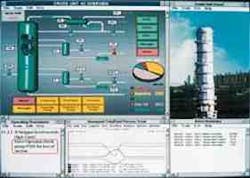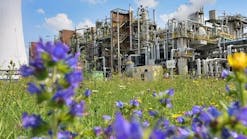Anne K. RhodesThe proliferation of new integrated process plant management systems is changing the way petroleum processing plants operate while bolstering their profits.
Refining/Petrochemical Editor
Such plant-wide information systems are introducing greater efficiencies and improving productivity in refineries, petrochemical plants, and gas processing facilities.
The hardware and software advances spurring this change have come in response to process plant operators' need to get a better handle on information technology management in an increasingly competitive market.
Virtually every major vendor of process control hardware and software has disclosed-or soon will disclose-availability of a new plant-wide information management system. These products use a common computer operating system to connect process control and business management functions.
Traditionally, process plants have used distributed control systems (DCS) to control operations. But the new crop of plant management systems links the DCS and its data with systems that govern business and plant functions such as billing, planning, scheduling, maintenance management, laboratory information, and process simulation and modeling.
Among the major process control suppliers to the petroleum and petrochemical industries that have introduced new plant-wide control systems are:
- Foxboro Co., Foxboro, Mass., Intelligent Automation (I/A) Series.
- Honeywell Inc., Phoenix, TotalPlant Solution (TPS).
- Fisher-Rosemount, Austin, PlantWeb.
- IBM, White Plains, N.Y., Integrated Plant Information System.
- Asea Brown Boveri Inc., Stamford, Conn., Advant.
Elsag Bailey is set to introduce a similar system at this month's Instrumentation Society of America meeting.
The term "distributed control" describes the use of multiple microprocessors to control a process plant. These new systems take this concept a step further by distributing that control out into the field devices, such as valves and transmitters.
"What makes that possible is fieldbus technology," said Keith Larson, editor of Control magazine.
Before fieldbus, each instrument, flow meter, and valve had to be wired to the control system separately. But by enabling all these devices to communicate over a single wire pair, fieldbus has created a plant network (see related article, OGJ, May 20, p. 78).
Handling more data
The new process control systems are easily integrated with existing systems and software. They also are modular and scale able-an important selling point.
DCSs typically start at $80,000-100,000 and are used to control large plants and handle hundreds of data sources. The new systems, by comparison, start at about $10,000 and manage as few as 10 input/output (I/O) points.
Bill Gates, chairman and chief executive officer of Microsoft Corp., Redmond, Wash., said, "Manufacturers in the process industries have unique and demanding requirements for information technology. Their competitive environment requires faster responses, improved productivity, and better management of plant assets.
"To really thrive in this environment, they need a seamless flow of information from the plant floor to users across the enterprise," said Gates.
"The increased 'intelligence' in smart devices such as...valves and transmitters is providing data about the process and the equipment that runs it," he said. "The game will change as integrated, modular software applications emerge and take advantage of this new information."
If the market supports the vendors' attempt to move from DCS-based control to plant-wide control, the shift will be similar to one with which Gates is familiar: the replacement of mainframe computers with client/server systems.
Scott McLagan, vice-president of marketing for Fisher-Rosemount, sees the shift as a natural progression brought on by technological advances.
"All the fundamental pieces that are required in this architecture are emerging," said McLagan. "There has been a common vision of the direction of the architecture for a number of years."
Instrument engineer adds I/O module to DeltaV controller assembly while unit is powered and operating. The modular nature of new integrated plant management software systems will make it easier for small processing plants to achieve high-quality control and easier for them to get all the pieces to work properly. Photo courtesy Fisher-Rosemount Inc.
Driving forces
Several key trends in process control technology are acting collectively to make these new systems possible.
Daniel Miklovic, a senior analyst with Gartner Group, Seattle, says one of the driving forces is the emergence of rugged, low-power integrated circuits that increase the performance, reliability, and communications capability of field devices and give them the ability to monitor themselves and the equipment around them. This ability is known as "intelligence," and the devices that have it are called "smart."
A number of field devices are now available in an intelligent form, including transmitters, valves, pumps, flow meters, and motors.
John Berra, president and general manager of Fisher-Rosemount Systems, Austin, explained the effect of this increased intelligence:
"Intelligent field devices such as smart valves and transmitters create an exponential growth in the amount of process, asset, and production information available," said Berra. "Distributed control systems were never designed to handle this step change in information 'bandwidth,' and so the DCS architecture allows only incremental improvements."
The growing adoption by industry of the Windows NT operating system is another factor that has contributed to the developing change in process control strategies. Gartner described Windows NT as "the first widely used PC operating system with the robustness necessary for process automation."
"All the new systems that have been introduced in the past year are Windows NT-compatible," said Larry O'Brien, a senior analyst with Automation Research Corp., Dedham, Mass. "Foxboro was the first, with I/A Series on NT," he said.
It is Windows NT that integrates control systems with business functions. Some analysts predict that, by 2000, almost all major DCS manufacturers will use NT as their primary platform, according to Larson.
Advances in personal computers (PCs) also are supporting this fundamental shift in control strategy. The silicon used to make microprocessor chips is much more robust and can now be put out in the field and used to control smart devices. And PCs are better able to handle the information load necessary to control process plants.
Another key factor, according to Larson, is users' need to integrate several sources of plant data and to use these data to develop preventive and predictive maintenance strategies.
"When you tie all these trends together," said Miklovic, "what you end up with is a new process automation architecture-a process control 'Internet' where anyone in a plant function can have access to real-time process and equipment information and be able to use that information to optimize the performance of the plant."
Taking advantage
Process control is an area that holds significant potential for improving refinery profits.
"We know so little about what happens in our processes," said Miklovic, "and we try to control them with incomplete information."
Vern Trevathan, manager of integrated manufacturing control for Monsanto Co., St. Louis, says the potential benefits available from a well-managed process control system are enormous.
"A few years ago, Monsanto performed a benchmarking study and found that, on average, a 'good' chemical company should be able to get about 6% of the total cost of goods in benefits from process control systems," said Trevathan. As a result of its study, Monsanto instituted a process control improvement program that has narrowed the gap between the process control benefits it is achieving and the 6% target.
"In fact," said Trevathan, "we've gotten so much of that gap that we realize the 6% itself was quite conservative."
Monsanto also has found opportunities for improvement in the performance of field instrumentation-control valves, in particular-and in predictive information about equipment failures.
"It does mean that we need a lot more information from the field devices," added Trevathan. "Getting more information from them-particularly information about impending failures or degradation of performance of that instrument-is really key," he said.
Typical global user station display is depicted in this image provided by Honeywell Inc. Such integrated plant management software/hardware packages are introducing greater efficiencies and productivity in petroleum processing plants.
Predictive maintenance
Fieldbus has created a plant network that opens up a possibility processors such as Trevathan find exciting: improved ability to perform preventive and predictive maintenance.
According to Dave Beckman, vice-president of marketing for Fisher Controls, Marshalltown, Iowa, maintenance spending typically amounts to 9-30% of the cost of goods sold.
Beckman also says companies spend about 15% of their time working with equipment data, and he expects this number to increase to 40% as processors move from preventive maintenance to predictive maintenance, and even a step beyond, to what Fisher-Rosemount calls "performance maintenance."
While the new process control systems announced to date have the ability to interface with predictive maintenance tools, most of the vendors rely on partnerships with maintenance software suppliers for predictive capabilities. The control systems offered by these suppliers take more of a top-to-bottom, vertical integration approach to plant information management.
By comparison, Fisher-Rosemount has designed software specifically for predictive maintenance purposes.
"Fisher-Rosemount is leveraging its strength in field devices through its Asset Management software," said O'Brien. "The real challenge is to take that mountain of data and turn it into useful information."
"Fisher is taking a radically different strategy," said Miklovic. "It is a 'bet-your-company' type of move, in some respects. What they are doing is new, it's innovative, it's a totally different approach," he added.
Miklovic also says Fisher-Rosemount has taken previously unusable data-"noise from pumps cavitating and things like that-where they used to throw it all away, now they're using it to diagnose the process," he added. "The question is: 'Will they be successful?'"
Fisher Controls can even tap into a plant remotely over telephone lines, check on valves, and recommend to the operator which ones need to be repaired and when repairs should be performed, according to Larson.
"Their concept is to take on a lot more of this functionality that used to be within the end-user organization," he said.
Charles Bailey, vice-president of manufacturing for Eastman Chemical Co.'s Tennessee Eastman division, Kingsport, Tenn., said, "One of the important strategies we're using is to focus on reliability-centered maintenance as a way of increasing our equipment 'up-time' and reducing our maintenance and manufacturing costs. We feel that the...Asset Management Solutions software...is a way to help us improve management of our production assets and to integrate our predictive technologies.
"We've developed a lot of predictive technologies over the past several years," said Bailey. "We've got expertise in vibration analysis, gamma scan, and other technologies. We've also purchased smart valves and smart pumps and tried to integrate a lot of these databases so that we could predict failures."
Bailey says Eastman's goal is to take all its individual success stories and integrate them to produce a system that enables Eastman to observe its data bases, predict failures, and eliminate system defects.
Scaleability
The improved scaleability of the new generation of process control systems is a legacy of advances in microprocessor technology, says Gartner.
When computers were hardware driven, a scale-up meant going to a completely different piece of hardware. Now, systems can be scaled up with a small change in electronic components or software.
"They had the capability before, said Miklovic, "it just was very expensive. You had to take the hardware out and replace it."
To achieve scaleability in the past, plants not large enough to require a DCS had to devise hybrid, build-it-yourself type control systems.
"When you build your own system, people are afraid to change anything," said Larson.
The customization required to make the old hybrid-type systems work meant that plants were highly dependent on the personnel who developed the system. If a plant's system integrator took a new job, for example, the company was left without knowledge of how its customized system worked.
According to Larson, the modular nature of the new systems will make it easier for small processing plants to achieve high-quality control and easier for them to get all the pieces to work properly. The new systems also are more readily tuned, will control better with a lot less effort, and are easier to maintain, adds Larson.
Fisher-Rosemount's PlantWeb system, for example, achieves scaleable process control through a device called DeltaV, which uses PCs and field-mountable controllers. According to Fisher-Rosemount, the scaleability of this product helps users take advantage of small or isolated improvement opportunities that offer significant payback for a low initial investment. And additional capabilities can be added as needed and linked with the existing applications.
Honeywell's TPS also can be scaled to fit plant-specific requirements. Through a combination of hardware and software additions, this system can be used with most of Honeywell's earlier products, including the TDC series of DCSs. And current users of Honeywell's DCSs can purchase selected components over time, thus converting their systems in an evolutionary manner.
Because TPS is based on industry-standard software and hardware, it can be applied in a wide variety of applications. MarkosTambakeras, president of Honeywell Industrial Automation & Control, says these applications cover a price range of $20,000-20 million.
Honeywell has sent about 100 TPS systems to beta test sites at operating plants. The Global User Station is the first available component of TPS.
Hardware vs. software
Process control suppliers have three main revenue sources: hardware, software, and services.
In the past, DCS suppliers made their money by selling proprietary hardware. Now, as hardware prices have fallen, they have begun purchasing more third-party components.
For the most part, the manufacturers of these products now assemble them rather than make them. As a result, the system value has migrated from hardware to software.
This change in focus from hardware to software represents the industry's efforts to broaden beyond traditional process control.
"It's a natural evolution," said Miklovic. "The days of making money on the proprietary hardware down to the control level are just about gone.
"Once a company makes the change from being predominantly a hardware company to predominantly a software company, it is...a step-change for the organization. But it appears to be more of an evolution industry-wise," he added.
Product acceptance
The first installations of these new products will be smaller pilot-type systems.
"A lot of the control system business in North American right now is replacement business-there aren't a lot of new systems being built, in general," said O'Brien.
"The fieldbus products will be proven out during probably the coming year," said Larson. "Some analysts have predicted that, by the year 2000, almost all of the major DCS manufacturers will have NT as their primary platform," he said.
In the meantime, suppliers must continue to support licensees of their earlier, UNIX-based systems, which are expected to last 10-15 years.
Larson predicts that the "takeover" curve for NT systems will be slower than was seen in the general computer industry. Processors are not expected to rip out their old systems and retrofit entire plants with the new systems. Rather, initial installations will be associated with plant expansions and replacement of worn out systems.
"Probably the biggest obstacle for the future is the whole human issue about these systems," said Larson. "How do you train people to handle this technology? How do you get them to adopt it, embrace it, and use it?
"Fieldbus is a whole different way of wiring up instruments," he explains. "It's no longer an analog electrical signal; it's a network.
"Your electrician can't just use a screwdriver and a Multimeter to diagnose your system; they have to use a network analyzer. So they have to be computer technicians, basically, instead of electricians," said Larson.
Petroleum and petrochemical processors have always been at the forefront of process control, says Larson. These industries are commonly thought of as the most sophisticated in the area of process control.
"They were one of the first champions of DCSs 20 years ago," said Larson. "They have led the charge in developing new systems and have been the earlier adopters and champions of things like fieldbus," he said.
The benefits of these new systems have not yet been demonstrated commercially. But, given the legacy refiners and petrochemical producers have created for themselves, they will likely continue to earn their pioneer status by being the first to take the risks associated with adopting these new products.
Bill Gates, Microsoft Corp. chairman and CEO
Manufacturers in the process industries have unique and demanding requirements for information technology. Their competitive environment requires faster responses, improved productivity, and better management of plant assets. To really thrive in this environment, they need a seamless flow of information from the plant floor to users across the enterprise.
Copyright 1996 Oil & Gas Journal. All Rights Reserved.



